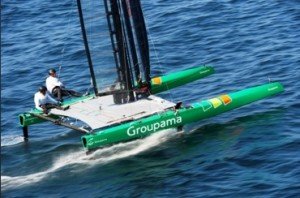Spread tow FRP by North Thin Ply Technology
Spread tow technology is one of the focused engineering in order to improve FRP properties, though there exist some methods.
Spread tow technology is the one to make fiber strand thin and wide.
Industrial technology center of Fukui Prefecture is leading this technology in Japan.
http://www.fklab.fukui.fukui.jp/kougi/
Spread tow leads to the proper impregnation of the matrix resins and the stress transfer efficiency improvement.
North Thin Ply Technology proceed their business by the simulation and automated lay-up technology, adding to the spread tow..
http://www.thinplytechnology.com/index.php?lg=
ThinPreg™ 80EP, curing at 80 degree C, is now available for the marine products mainly and North Thin Ply Technology modified the prepreg.
(The Photograph below is referred from http://www.thinplytechnology.com/news-93-ntpt-upgrades-its-marine-prepreg-product-range )
There is no doubt that they can design and modify the matrix resins by themselves, and the skill shall be the big advantage comparing with the competitors. Their business style would be one of the good example if you are now considering to enter FRP industries.
I would like to try to summarize the main business of North Thin Ply Technology.
About the spread tow technology;
They mentioned that the areal weight of PAN FR, Pitch CF and S Glass can be decreased up to 18gsm(gram per square meter), 5sqm and 35sqm respectively.
About the simulation technology;
They can do meshing and run FEM stress analysis, adding to the automated lay-up control by the software of Thin Ply Mesh Idealization ( TPMITM ).
(There is no detailed information regarding meshing method like solid or skin.)
FEM analysis logic for FRP has not been fixed, so there is no idea what stage of North Thin Ply Technology is at this moment regarding the FRP simulation technology. However, it shall be interested that they can do the meshing process which takes very long time.
The main role of TPMITM seems to be the automated lay-up technology, rather than FEM. The software of TPT® Layout enable them to simulate the material position and 2D preform for automated layup systems.
About the automated layup technology;
North Thin Ply Technology adopts ATL ( Automated Tape Laydown ). The layup highest speed is 450 m/h, they can complete layup 135sqm (square meter) per an hour if the layup width is 300mm. The software like TPT® Layout has an important role to increase layup layout accuracy.
Automated layup technology shall be the one of the biggest trend, considering the layup process takes the longest time in the FRP manufacturing process.
What can we learn from North Thin Ply Technology news?
The first point would be the combination of the various of business like materials, simulations and automated layup, because such kind of wide range of business enable them to respond the customers' request.
If the customers have the request of the proposal about FRP products, North Thin Ply Technology can discuss from the automated layup process of the products. In addition, they can also propose the proper matrix resins and prepregs, considering layup process.
You may run FEM analysis in the different companies because there is no serious issue if you do not forget the important concept that the correlation between test and analysis shall be checked by boundary conditions and meshing method.
The most important here shall be the material proposal availability.
The spread tow technology is also the important one.
The improvement of thickness accuracy and draping properties shall be the another advantage of the spread tow technology, adding to the higher mechanical properties. Thin ply prepreg shall be the key technology, especially we try to complex shape products because the layup process for making the 3D shape needs longer layup time and higher thickness accuracy.
By contrast, what problems does North Thin Ply Technology have?
The first problem would be the ATL machine.
You can see the picture of ATL and understand that they may do layup only the closely flat surface.
(The photograph below is referred from http://www.thinplytechnology.com/automated.php)
This ATL machine shall work for very large products with the almost flat surface but the 3D surface is necessary for FRP products. It is also considered that you can do layup on the flat surface once, then charge to the 3D surface cavity of the dies. But alignment of the fiber will be changed during curing or molding process and the error aligned fiber products can't show the designed properties.
.
If they would like to do layup on 3D surface by ATL, they would need to use the narrow and multiple fiber strands simultaneously.
Of course, we shall not forget that thinner plies need longer layup time.
Today, I introduced North Thin Ply Technology having spread tow materials, simulation and automated layup system.





